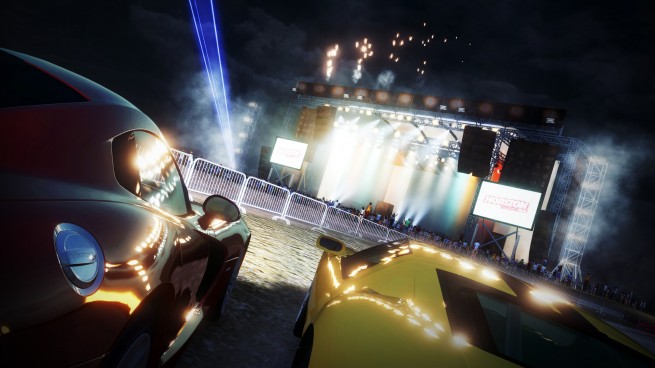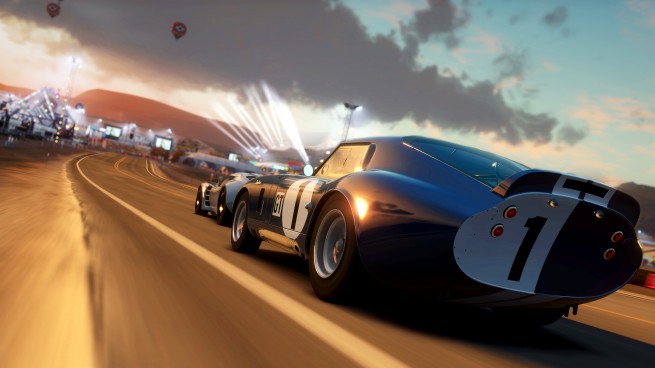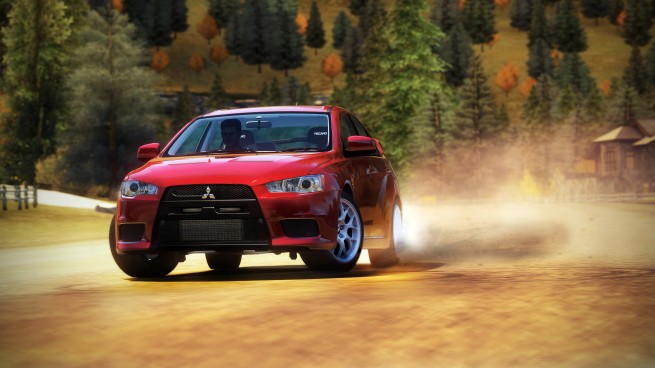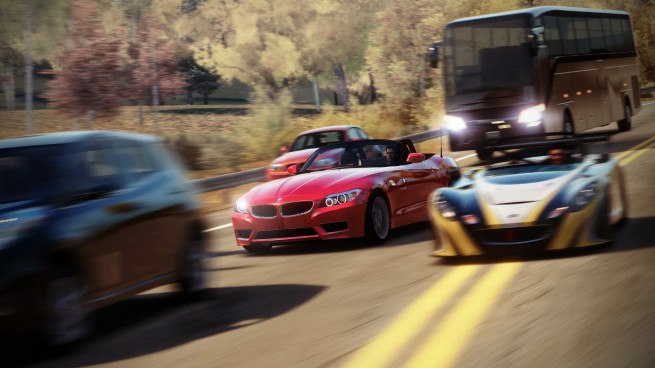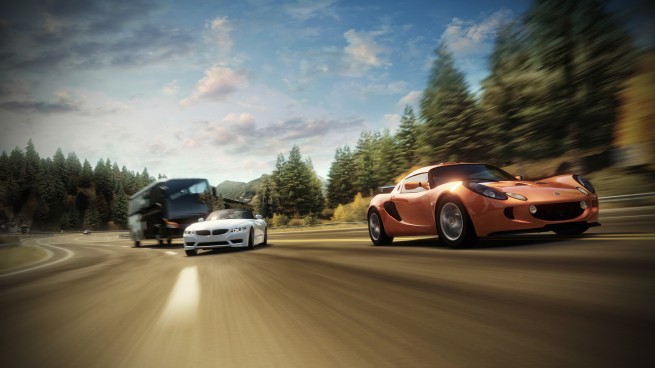When Turn 10 Studios first announced Forza Horizon, my eyes rolled so hard I momentarily viewed my frontal lobe. After all, when Electronic Arts attempted a “hipper” spin-off of the Need For Speed series, we got Need For Speed: ProStreet. ProStreet was undoubtedly the beginning of the end for the Need For Speed franchise (at least in terms of quality, as EA seems hell-bent on beating that poor horse’s corpse into oblivion).
The similarities between Forza Horizon and ProStreet are undeniable: Both focus on a festival of sorts that is as much about raving, glowsticks, and an obscene amount of nighttime fireworks as it is about actual racing. It’s like Burning Man, only with Corvettes and tuners instead of hippies. In both games a DJ announces to everyone at the festival the current progress and exploits of the player as the unknown underdog works his way up to the top.
But Forza Horizon is not ProStreet’s spiritual successor. In fact, after a lengthy hands-on session, I would say Horizon is the game ProStreet should have been. The gameplay is better, the events are more interesting, and most important, it’s actually fun. While Horizon doesn’t reinvent anything, it’s now definitely a game I plan on picking up this October and having a blast with for 10 to 20 hours.
GamesBeat sat down to discuss the upcoming game with Forza Creative Director Dan Greenawalt, one of the most truly passionate game developers I know. Racing against hot air balloons, maxing out current generation hardware, and how Red Dead Redemption and Assassin’s Creed inspired Horizon — it’s all below.
[vb_gallery id=526937]
 GamesBeat: DLC has become a contentious topic. Forza is maybe one of the better examples of DLC practices, where you guys have continuously provided consistently quality updates. Is that something we can expect with Horizon?
GamesBeat: DLC has become a contentious topic. Forza is maybe one of the better examples of DLC practices, where you guys have continuously provided consistently quality updates. Is that something we can expect with Horizon?
Dan Greenawalt: Absolutely. DLC has become part of, in many ways, the Forza secret sauce. We keep the game fresh, right? The game always has value. There’s a reason for people to keep coming back. Because, let’s face it, there are blockbuster games that come out, and you can’t expect people to not play them. I want them to play them. I want gamer culture to flourish. That doesn’t mean I don’t want them to come back. Come back to Forza. There’s gonna be more cars. There’s going to be new types of Rivals events and stuff like that. That’s why we’ve seen our numbers…a big game comes up, they drop down. Three weeks later, they come right back up.
GamesBeat: Do you have a separate DLC team that works on the DLC?
Greenawalt: Yes and no. We actually have a content team that makes cars specifically. We’ve got content teams that make environments and things like that. That car team in particular is one that is just always making stuff. Whether they’re making it for a shipping product or making it for DLC, that never turns off. It’s a firehose. Whenever new cars…that was part of the deal with DLC, too. We can’t plan when cars get announced. And it takes us six months to build a car in the end. So to keep fresh cars in the pipe, if we’re only releasing a game every two years or so, there’s a whole lot of fresh content that comes out that we can’t capitalize on. By having those guys always searching — what’s the new hot thing? — as soon as we know about it, we put it in the pipe and then release it as soon as we can.
GamesBeat: With that said, about “every two years”…how did dev on Horizon impact the next Forza?
Greenawalt: I think what was said is that we’re always working. And yes, we’re always working. What we’re working on, we actually aren’t talking about. But Playground is actually a different studio. They’re located in the U.K. The strength there was…obviously, Turn 10 itself is located in Redmond, near Seattle. We’re able to draw talent from all over the U.S., Canada, and parts of Asia. By having a dev studio in the U.K., they’re able to draw talent from all over the U.K., which has tremendous racing talent, as well as all of Europe — Eastern Europe and the like. That allows us to have two dev teams working on the same engine: graphics engine, physics engine, A.I. engine, all of that. Rather than actually splitting one team into two, where you might have a good team and a bad team or this team and that team, we actually have two world-class teams working on the same engine.
GamesBeat: The Need for Speed team actually tried a similar game, kind of based around a music festival and everything, which was Pro Street. Was that a game that you guys looked at as an example of what to do or what not to do?
Greenawalt: Obviously, we play a ton of games. We’re gamers, and we’re car lovers. We looked a lot at Red Dead Redemption. We looked a lot at Assassin’s Creed. World of Warcraft.
GamesBeat: For a racing game?
Greenawalt: Absolutely. A foundation of Forza is innovation. You don’t find innovation by scraping the same ground, right? You have to go other places. So, yeah, we look at other games.
We also look at pop culture. We look at movies. We read a lot of books. We read psychology. You’re looking for how to affect people’s mood and emotion. You look at movies and you see how…like Black Hawk Down or Saving Private Ryan before that, the way they filmed things. That started influencing games. Did it only influence shooters? Of course not. It influenced all sorts of games.
It would not be a very winning strategy to look at a two- or three-year-old game in our same genre for our place of inspiration and innovation. The best it could do is give us warnings about things not to do. Honestly, we’ve got a lot of our own learnings we’ve done about what not to do. Part of the process of innovation is starting with hundreds of ideas. Ideas aren’t the problem. It’s finding the right idea at the right time.
You start with ideas; you whittle that down, then you prototype, and then you throw most of that away, to have the real ideas that are innovation that helps people. Like the Kinect integration, using voice to set the waypoint. That’s built on top of the green-line innovations. Those two innovations combine to do something that’s not just helpful in a driving game. It could be helpful in a lot of open world games.
GamesBeat: Now I’m curious: What are some of the specific examples of something like Red Dead or Assassin’s influencing Horizon?
Greenawalt: A lot of emergence. We’ve got these random encounters that happen, like when you’re driving around and there’s another hot street car that’s out there that you can challenge. You think about the random encounters that happen in Red Dead Redemption. There’s two guys robbing a stagecoach on the side of the road, and it turns out all of them were acting, and they were just gonna try and ambush you. These emergent encounters that happen randomly.
There’s also collectibles in Assassin’s Creed, as well as Red Dead Redemption, but especially Assassin’s Creed, where they’re kind of hidden. That sort of thing inspires our barn finds, that you can go search out. What it’s doing is giving the player… It’s giving them motivation to go explore. In exploring, they’re building relationships with the cars.
GamesBeat: I saw that you can buy a DLC treasure map. Can you explain the “barn find” a little more? There’s nine of them in the game to start with?
Greenawalt: So barn finds are basically classic cars. Think like a BMW M1, right? A cult classic car. They’re hidden throughout the world, in barns or in industrial areas or under a tarp here and there. They’re in pretty rough shape. They’re off the beaten path, so you have to go find them. You hear over the radio in the game, “Hey, there’s a rumor of a barn find in this general area.” Then we highlight the big area. What we’re getting people to do is just go search. It’s not racing. You’re not driving fast. In fact, you tend to…I race in first-person view. But when I’m looking for a barn find, I tend to go to third-person view. I drive real slow, and I’m panning the camera around to see. Where is it? Where is it?
GamesBeat: Shouldn’t you already know where all the barns are?
Greenawalt: Uh…yes. [Laughs] But at the same time, as a gamer, when we hook something up…and we’ve moved the barn finds around quite a lot, actually, to find the locations that inspire the kind of exploration we wanted to get. They also unlock randomly, by the way. So it’s not like it’s a linear thing. The rumors happen kind of randomly, leading to people’s profiles that you’re going to unlock in different sequences.
GamesBeat: And you can destroy the signs for upgrade discounts?
Greenawalt: Yeah.
GamesBeat: Can players, just from the very beginning, can they go out and find all 100?
Greenawalt: Yes. But barn finds are interesting, because you have to hear about the rumor before you can find it. Even if you knew where they all were, you couldn’t go get them all at once. Upgrades are different. The upgrade ones, you can go do all of that. Now, the system itself, I don’t believe it’s unlocked until about 10 or 15 minutes into the game. We don’t just dump it. The challenges, the popularity mechanic, the showcase, we don’t just dump that on players. It would be a bit much. But I think it’s within 15 or 20 minutes…the upgrade stuff becomes available. Once that’s available, you could drive around the entire map and just go find all of them.
GamesBeat: And that would give a 100 percent…would upgrades then be free?
Greenawalt: I don’t know if it goes to 100 percent. I think it does, actually, so, yeah….
GamesBeat: There’s a hundred of them, and if you get every single one….
Greenawalt: They’re 1 percent to begin. I just don’t recall how we meter it out. I think it is 100 percent, when you get to all of them. So, yes, upgrades would be free.
GamesBeat: You were saying that it’s a pretty large world. Do you have some exact mileage?
Greenawalt: No. I mean, there’s hundreds of miles of road. It’s a huge amount of square mileage. But I don’t have the exact numbers.
GamesBeat: Do you know how long it takes to drive across the world or anything?
Greenawalt: Well, it’s kind of curvy. [Laughs] One side to the next…no, I just haven’t tested it that way. For us it was really about having the right amount as you’re playing it. We weren’t shooting for a certain size. We just never looked at it that way. Basically, we were adding roads based on what kind of experiences we wanted to give people, regionally. We planned out the regions first, like Red Rocks and Snowy Mountain and Vale, all of that. Then the density of roads and how big those areas had to be was based on driving around in a white box world — that’s a world with no skin — to have the right amount of “Yeah, OK, I’m still driving. I haven’t seen everything yet” so we could get a lot of hours of gameplay out of it.
GamesBeat: The showcase events are pretty interesting — and unique, too. There’s not a lot of opportunities to race planes and hot-air balloons in other games. [Laughs] When I was playing, it was incredibly close. Like within a second. The plane was always hitting those checkpoints within a second, either right before me or right after me. Then, at the very end, you could see it swooping around and coming in, so you’re literally going for that final checkpoint head-on. It seemed very cinematic, and I was wondering if there’s kind of a rubber-band program to make those showcase events a little more cinematic?
Greenawalt: The plane does take a slightly different route, the same way A.I. does in a race. It’s not really rubber-banding. He takes a different route, though. And there’s difficulty settings in the game. So it’s sloppy. There’s slop. Then, based on the amount of difficulty you’ve got — easy, medium, or hard, for the A.I. opponents in a normal race — that changes the overall profile. And then he has slop within that. But it’s not a….
GamesBeat: It’s not just smoke and mirrors to make it closer.
Greenawalt: All gaming is smoke and mirrors. [Laughs] But the answer is no, it’s not cheated. But yes, everything is smoke and mirrors.
GamesBeat: If there’s not a rubber band in place, as in Mario Kart and a lot of other games do rubber-banding to cover for poor gameplay or A.I. design…in my first race, I totally smoked everyone else. They weren’t even close to me. So if I do well, if I do better than them, I don’t want them all of a sudden behind me. But the plane level was incredibly balanced, then. You did really well, if there isn’t anything to manufacture that experience. That was really cool.
You guys have amazing relationships with all the biggest manufacturers, like Porsche, or course. But that was always for racing on a circuit, professional racing, stuff like that. Did the relationship, or some of their concerns, change when now you can drive head-on into oncoming traffic and bust through fences and hit civilian cars and stuff like that?
Greenawalt: If we approach them saying that we’re making a game about smashing, and the car’s a weapon, and it’s about taking people down and destruction and all of that, of course they would have had issue with that. Why wouldn’t they? They’ve got a brand to protect. But the truth is, the reason our relationship is so strong is because we’re a very vision-driven franchise, a vision-driven studio. It is about turning gamers into car lovers and car lovers into gamers. They look at us as like…we bring a lot of innovation with things like Auto Vista. We bring innovation with the way we socially engineer the way people get together and talk about cars.
So the way we approach them is the same way we would for Motorsport. We don’t even start, with Motorsport, saying it’s about simulation. We go to them and say, this is about getting people excited about cars. And then we tell them about features. Yes, it is in an open world environment. Yes, there is traffic. But it’s about glorifying cars. The car’s not a weapon. And we also want to build relationships with cars. They’re not disposable. So instantly, it’s much easier to have a conversation about individual features. Because the features aren’t as important, and they know that our heart is in the right place to defend their brand. We’re not trying to borrow against their brand to create some sort of crazy mayhem or…something that actually looks bad for them, honestly.
GamesBeat: We mentioned Assassin’s Creed; those guys are saying that they maxed out the current generation of hardware. That’s been pretty much the sentiment from a lot of other triple-A developers. Would you say that that’s also been your experience with Forza?
Greenawalt: This is the funny part about hardware. That rhetoric, “maxed out the hardware.” The very first PGR maxed out the hardware. You’ll always use all of the hardware. The thing is, it’s like packing a moving van. I’ve used this analogy before. If you just emptied your apartment into a moving van, you’d fill it up, right? If you then unpacked everything on to the street and planned it out a little bit better, you’d find room, and you’d fill it up with more stuff. So then you unpack it again and repack it. You’re going to find even more room, but a little bit less. It’s like limits in math. You’re never going to reach that total limit, but you can always find efficiency.
Every year, when we’re on a stable platform — and that’s the great thing about console development. It’s stable — you find more and more optimizations. But you do reach a point of diminishing return. That comment about “maxing out the hardware”: Given more time, you keep finding optimizations. And the optimizations don’t make things worse. All you’re doing is finding new ways to rearrange the math so everything fits in.
GamesBeat: Do you feel like the incremental increase in the efficiency or whatever has kind of gotten a little bit smaller…?
Greenawalt: It always gets smaller. But I guess that the thing that always….
GamesBeat: Too small, maybe?
Greenawalt: No, I don’t think it’s too small. It does mean it’s hard work. It’s easier if you just get thrown…it’s a lot like cars, right? How’s it easier to go faster? Is it easier for you to get better, or maybe even lose weight as a person, or is it easier that I give you an extra 100 horsepower? Horsepower, right? But if you put me in a Corvette, and you put a professional race car driver in a Corvette, he is a lot faster than me. You give me 100 horsepower, maybe I beat him? I probably don’t. Because he’s just that much better. When you’ve got a really good engine and a really good dev team and you’re really optimizing the hardware…of course it’s more powerful.
But at the same time, you keep optimizing. There is, of course, a sweet spot. Three years into a piece of hardware? Where everybody’s sharing a lot of secrets. You’ve got Epic and 343 and Turn 10. We’re all going to GDC and going to DICE and sharing little tricks about how to optimize your lighting and all of that. That’s where you get these big leaps and bounds. Then things get a lot trickier. But we still have great optimization. Forza 4 looked way better than Forza 3, and this game looks fantastic. You’ve got the realtime lighting system, all the shadows creeping across, and the god rays coming in. It looks great. It’s a question I get asked a lot, and the reason I use an analogy is because it’s simply not as simple as saying “Is more power good?” Well, actually, if it’s more power, but the hardware is more complex, no, it’s not good.
GamesBeat: AndtThe team would have to learn new hardware, and switching over consoles is always a big event for companies.
Greenawalt: I was on PGR on the original Xbox, and then obviously Forza 2, moving to Xbox 360. Those are very trying times.
VentureBeat's mission is to be a digital town square for technical decision-makers to gain knowledge about transformative enterprise technology and transact. Learn More
